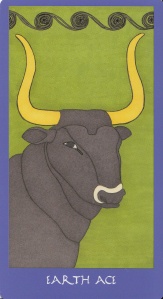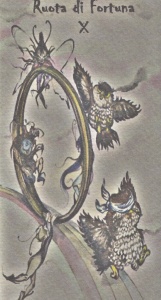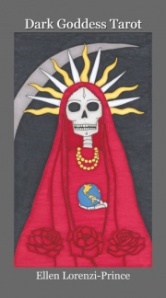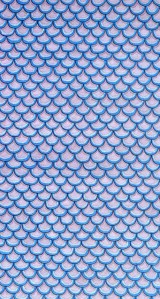The Minoan Tarot
Author: Ellen Lorenzi-Prince
Artist: Ellen Lorenzi-Prince
Foreword: Rachel Pollack
Arnell’s Art
2014
ISBN #978-0-9894739-3-4

The “Minoan Tarot” is inspired by the people of ancient Crete – their devotion to their Goddess, their land, and their creativity. The imagery is based on frescoes, pottery, sculpture, and jewelry from various periods in Cretan history. The 78 card deck and 92 page companion book come in a sturdy, lift-top box with the image of the Moon on the front. Other card images flow along the sides and ends of the box.
This is a traditional deck, with the following cards being retitled: Lily Prince (Fool), Priestess (Magician), Oracle (Priestess), Goddess (Empress), God (Emperor), Singer (Hierophant), Visionary (Hermit), Wheel of Life (Wheel of Fortune), Balance (Justice), Hanging Woman (Hanged Man), Ancestor (Death), Flow (Temperance), Ecstasy (Devil), Shipwreck (Tower), Transcendence (Judgement) and World Tree (World). Strength is VIII, Balance (Justice) XI. The suits are Earth (depicting land animals), Sea (depicting water creatures), Sky (depicting feathered creatures), and Art (depicting humankind involved in day to day activities). The Court Cards are Worker, Priestess, Master, and Mistress, and reflect social roles and cultural traits.
In her foreword, Pollack talks about the 1980’s as the beginning of a time when Tarot deck creators began to work with cultural traditions, many of which have been set in the past. She notes that this is a great learning tool, and that Lorenzi-Prince’s images are both true to their source, and alive and meaningful.
Lorenzi-Prince, in her introduction, talks about the fact that the Bronze age people of Crete, unlike their contemporaries, did not exalt kingship. Nor did they perceive of a great distance between the gods and humanity. She notes that each card in the Minoan Tarot is based on an original work of the painters, sculptors, jewelers, and potters who lived thousands of years ago.
She goes on to define the chronological tables of the periods that she refers to in this deck: Neolithic Era on Crete, Pre-Palace Period, Old Palace Period, New Palace Period, and Post Palace Period, and gives us a brief history of the Minoan culture.
The cards are presented with a full color image, a history of the symbols used in the card, and three short messages. For the Minor Arcana, note is made that the suits (Earth, Sea, Sky, and Art) reflect the great powers present in the lives of the Minoans. The numbers are defined as: Ace/Individuality, Two/Sensitivity, Three/Creativity, Four/Practicality, Five/Adaptability, Six/Harmony, Seven/Spirituality, Eight/Power, Nine/Consciousness, and Ten/Transformation. The Court Cards carry the following qualities: Worker (physical, practical energy of the suit), Priestess (spiritual direction and action), Master/Mistress (aspects of the God and Goddess as reflected through each of the suits).
At the end of the LW (Little White Book) we see samples for several three card readings, and a list of selected sources.

The card backs are red, with a gold labrys – a double-headed axe-like symbol of the Goddess, and a ceremonial tool for ancient priestesses. The backs are not reversible. The card faces show a lavender/blue ¼” border, surrounding a central image. Across the bottom of the card in white lettering, we see the card number (in Roman numerals) and title (for the Major Arcana), suit and title (for the Court Cards), and suit and number (in text) for the Minor Arcana pips (numbered cards).
The images are modern renditions of ancient images, done primarily in shades of blue, purple, gold, and green. Symbols include snakes, Gods, Goddesses, eggs, and crescent moons.

Sky Master: This card is based on a gold pendant from the island of Aegina in the New Palace Period. The Master of Birds brings grounding and discipline to the soul’s search for meaning.

Art Mistress: The fantastical creature carrying the libation in this engraved gold ring from the New Palace Period is called the Minoan genius or demon. It always functions as a divine servant.

Sky Eight: This lovely crested bird is from a fresco of Knossos in the New Palace Period is a hoopoe. It is thought to rule all birds.

Sea Seven: The painted octopus, shown coiled around a terracotta vessel of the New Palace Period, shows the joy the Minoans felt in this creatures grace and flexibility.

Earth Ace: This finely carved ritual vessel comes from the New Palace Period. It shows how highly revered the bull was in Minoan culture.

The Moon: This image is from a fragment of a terracotta sculpture of the Goddess found in the Psychro cave. The Moon is the gateway to what lies beyond.

Balance: The image here is from an engraved gem seal from Knossos in the Old Palace Period. Two acrobats are standing on their hands, mirroring each other. The Minoans valued both physicality and deep religious feeling.

Wheel of Life: The Minoan Tarot Wheel of Life is from an Old Palace Period engraved gem seal, showing an interwoven design of egg and snake.

Singer: The imagery here is a group of terracotta figurines from the Cretan village of Palaikastro in the Post Palace Period. While less sophisticated than before the falloff the palaces, we are still shown that joyous religious rights lived on.
The “Minoan Tarot” functions well as a tool for journeying and meditation, as well as an oracle. The card meanings will evolve for the reader as they work with this deck, but it is important to work with the companion book when you first start using this deck in any capacity. The messages are all about stability and a grounded sense of well-being.
The work seen here reflects the exacting standards of both the author/illustrator, Ellen Lorenzi-Prince, and the publisher, Arnell Ando. It is a quality product, and a welcome addition for any Tarot reader/collector/afficianado.
© 2015 Bonnie Cehovet
Reproduction prohibited without written authorization from the author.






























